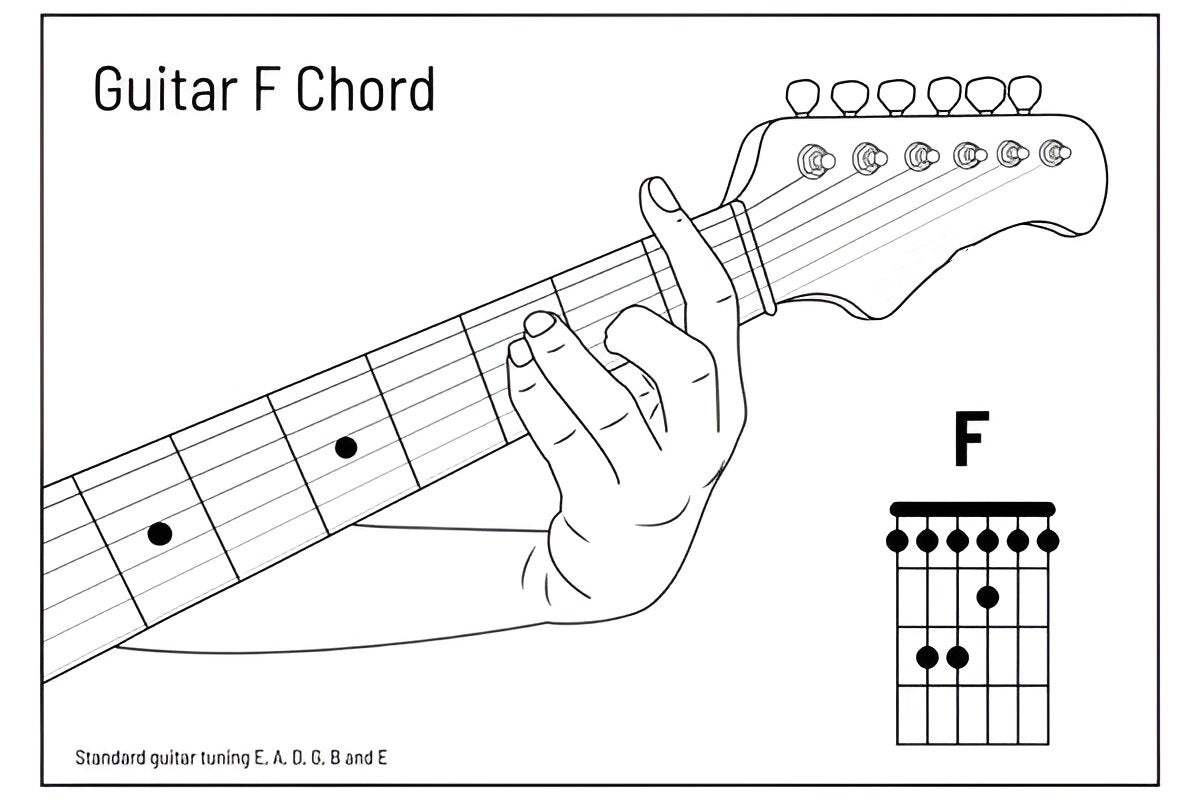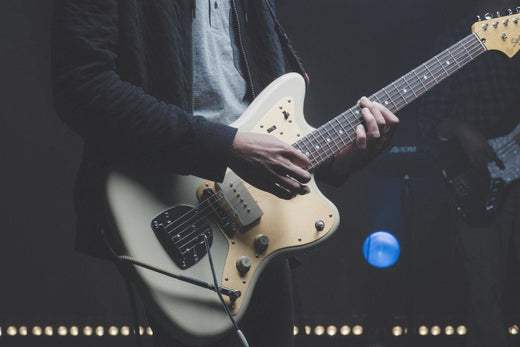Learning to play the guitar is a relaxing, enjoyable, and incredibly rewarding experience, and mastering the basic chords is the first step on the journey for any beginner. Chords are the foundation of every song ever written, and learning just a few easy chords will allow you to play many popular tunes in no time at all.
So let’s take a look at the easiest guitar chords for beginners, find out how to play them, and share some tips for practicing effectively.
What Are Guitar Chords?
A chord is a combination of notes played at the same time. They are formed by pressing your fingertips down on the guitar strings at specific frets while strumming or picking the strings with your other hand. Chords can be major, minor, or more complex, such as seventh, minor seventh, suspended, etc.
Why Should I Start with Easy Guitar Chords?
The easy way is always better than the hard way, particularly on the guitar. There are plenty of difficult chords waiting to be learned, but by starting with the easiest chords on the guitar, you will build finger strength, flexibility, and muscle memory. This will make the harder chords that you encounter later on your guitar journey much easier to play.
Simple chords also make it easier for you to play entire songs in a relatively short amount of time, which keeps practice engaging and fun. This motivates you to keep practicing, making you a better guitarist as every day passes. Once you become comfortable with these basic chords, they will open the door to more advanced playing techniques.
Essential Easy Guitar Chords
It’s now time to find out how to play some of the easiest guitar chords for beginners. I have used the names of the strings in my explanations, so if you haven’t learned them yet, now is a great time to start. The thickest string is called the Low E String, underneath that is the A String, then the D String, then the G String, then the B String, then the High E String.
Let’s start with the…
A Major Chord - A

Place your ring finger on the 2nd fret of the B string, middle finger on the 2nd fret of the G string, and index finger on the 2nd fret of the D string. This chord should be strummed from the 5th string down, but don’t worry too much about that at this early stage. With time, you’ll end up muting the Low E String with your thumb, allowing you to strum all six strings while only hearing five, but forget about that for now.
The A chord will probably sound terrible when you first strum it, but again don’t worry, move your fingers about a little to see if that helps, then strum again. Now rest your hand, then place your fingers back in position and play all six strings of the guitar one by one. Some will sound great, some won’t, so it’s time to find out why.
The most common problems are:
- Muting the string with another finger - to fix this, remove all your other fingers and make sure that the string rings true. If it does, add another finger to the chord and make sure that the string still rings, if it does, add the final finger.
- Finger too far from the fret wire - You need to get all of your fingers close to the frets (the steel strips running across the neck). Try moving your fingers closer to the fret if possible.
- Not pressing hard enough - If you are not pressing the string down enough with the fingertip, it will not ring properly. Once again, remove your other fingers and just play one note, pressing it hard enough to make it ring. Then add one finger at a time again making sure you keep pressing the string hard enough to ring. As you improve, you will learn the best position for every finger and not need to press as hard as you do as a beginner.
All this information applies to all the other chords I will be covering next, but before that, I’ll just mention the dreaded pain that beginners go through.
Pressing a finger hard onto a thin piece of wire will understandably hurt a little. The pain will decrease as you develop calluses on your fingertips, but that will take a few weeks. There is no way around this pain, but you can make it much less painful by restricting your practice sessions in the first month to around 10 minutes at a time. You can do more than one session a day but with at least a few hours in between them. Also, don’t practice straight away after you’ve had a long bath or washed the dishes, your skin will be weaker due to exposure to hot water, so let it dry out for a while before you practice.
Time for the next chord…
E Major Chord - E

Place your index finger on the 1st fret of the G string, your middle finger on the 2nd fret of the A string, and your index finger on the 2nd fret of the D string.
D Major Chord - D

Place your index finger on the 2nd fret of the G string, your middle finger on the 2nd fret of the High E string, and your ring finger on the 3rd fret of the B string. Strum from the 4th string down.
C Major Chord - C

Place your index finger on the 1st fret of the B string, your middle finger on the 2nd fret of the D string, and your ring finger on the 3rd fret of the A string. This might be quite a stretch at this stage, but stick with it, it will get easier. You should strum from the 5th string down, but as with the A chord, you can strum all the strings for now.
G Major Chord - G

Place your index finger on the 2nd fret of the A string, your middle finger on the 3rd fret of the Low E string, and your ring finger on the 3rd fret of the High E String string.
A Minor (Am)

This is the same shape as the E chord that we’ve already played, but every finger is down one string. Place your index finger on the 1st fret of the B string, your middle finger on the 2nd fret of the D string, and your index finger on the 2nd fret of the G string.
E Minor Chord - Em

This is the same as the E Major chord that we’ve already covered but without the first finger. Place your middle finger on the 2nd fret of the A string, and your ring finger on the 2nd fret of the D string.
How to Change Between Chords Quickly
Knowing how to play the chords and make them sound good is unfortunately only half the battle when learning guitar. The other half is learning to smoothly transition between them, so here are some tips to make the changes as quick and easy as possible.
Practice Fast and Slow!
Common sense would dictate that you should focus on accuracy over speed. And that is true to some degree, so practice making the chord sound as good as you can, as explained earlier, i.e. play every string one at a time and try to find the problems and correct them, then change to another chord and do the same.
But if you only do this, it will take you a long time to develop speed. So, mix it up, do the slow precise changes for 2-3 minutes, then try and change between the chords as quickly as you can for 1 minute. Don’t worry about how they sound, which will probably be terrible, you’re teaching your hands and your brain to cope with this level of intensity.
Over time, you will change the perfect chords quicker, and your speed changes will get more precise until you can change the chords perfectly at breakneck speed.
Use Anchor Fingers
Look for Anchor Fingers between chords, for example, to change from Am to C you only need to move one finger, two fingers remain in the same position.
Minimize Finger Movement
Keep your fingers as close to the fretboard as you can when changing chords and move your fingers the shortest possible distance. For example, since E major and A minor are exactly the same shape, keep your fingers in the same position and simply jump between the two chords without any unnecessary finger movement.
Slide Between Chords using Anchor Fingers if Possible
If two chords have notes on the same string using the same finger, then slide that note as opposed to lifting the finger and putting it back down. For example, to change between D major and E major, play the D chord, then lift your middle and ring fingers, now slide your index finger back a fret, and place your middle and ring fingers back on the fretboard to make the E chord. Reverse the process to go from an E chord to a D. This also works for the change from A to D and D to A by sliding the ring finger.
Tips for Effective Practice
Practice does not make perfect - Quality Practice makes Perfect!
The ideal daily practice session only needs to last around 20 minutes. Or if you are just starting out and experiencing finger pain, 2 x 10-minute sessions. The secret is to only practice what you can’t play, this is simple when you are a complete beginner because you can’t play anything well. However, when you do master your first song, scale, or riff, then you can’t ‘practice’ it anymore, you can play it all day long, but you can’t include it in your practice time. Your practice session should only involve working on things that you can not play.
Play Along with Songs
Do an internet search for 3 chord songs by your favorite band, then check the songs to see if they contain the 7 easy Guitar Chords we’ve covered. If so, play along with the original song as soon as you can. It’s really boring playing a chord progression for a minute by yourself, but if the song is on and you're playing with it, you can easily practice that same progression for four to five minutes.
Wrapping it Up
Learning easy guitar chords is the best first step for any aspiring guitarist. Practicing them using the methods I’ve described will build a solid foundation for more advanced chords such as the other root chords, and then the dreaded barre chords.
Remember, consistency and patience are the secrets to success on the instrument - happy playing!





